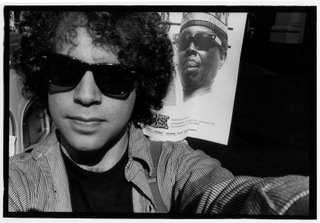
There's a line on Bob Dylan's 2001 CD 'Love & Theft' - it kind of sneaks right up on you - "Big Joe Turner looking east and west from the darkroom of his mind." It's a photography reference sure enough - right there at the opening of the song 'Highwater (for Charlie Patton)'.
What's up with Bob Dylan and photography? Just recently he's put out 2 CD's with photography illustrated covers. Not pictures of himself. Just cool photographs picked out by himself? When the CD 'Modern Times', came out in 2006 - I immediately recognized the cover photo. A beautiful black and white shot by Ted Croner - 'Taxi, New York at Night, 1947' - which I had seen, and ogled over, many times at the Museum of Modern Art. And on this year's CD 'Together Through Life' there is a cover photograph from Bruce Davidson's 1959 teenage gang essay, and a back cover photograph from Josef Koudelka's book on Gypsies. Both great black & white photographers themselves. Now I also happen to know that there was almost a photograph by Andre Kertesz on the cover of his recent book 'Chronicles'. So there's obviously something happening here.
Bob Dylan's always been involved with the photographers that shoot his covers. There are the great middle sixties shots done by Daniel Kramer (Bringing It All Back Home, Highway 61 Revisited), Jerry Schatzberg (Blonde on Blonde), and Barry Feinstein (Times They Are a Changin' + the No Direction Home DVD). All are collaborations with the photographer. The dangling camera on the cover of Highway 61 - truly a visual non-sequitor - is in itself a nod to the presence of the photographer, prominently placed within the portrait of the artist as a young motorcycle rider. And recently it's been revealed by Schatzberg that it was Dylan's decision to use the slightly out of focus shot for the cover of Blonde on Blonde.
What I find truly interesting, is that Bob Dylan goes not just to great musicians to record his music, but he goes to great photographers to capture his image. Most recently, the cover portrait of 'Tell Tale Signs' last year, was shot by William Claxton - noted for his fashion and jazz photography. While the inner sleeve of 'Love and Theft' has a portrait by David Gahr - he had shot Dylan as far back as the village and Newport Folk Festival days. And these many years later in 2007, known to be in ill health, Dylan seeks him out to shoot his portrait. Both David Gahr and William Claxton died in 2008.
One last storyline here, about photographer/musician/filmmaker John Cohen, who is name-checked in the liner notes for Highway 61 Revisited:
"You are right john cohen, quazimodo was right...there is no eye...i cannot say the word eye anymore...your rooftop - if you don't already know - has been demolished."
It was John Cohen who shot the first film footage of a pre-signed Bob Dylan on his 3rd Avenue rooftop - you can see it in the Scorsese doc 'No Direction Home'. John Cohen, by the way, shot stills on the set of the Robert Frank/Jack Kerouac film 'Pull My Daisy'. Cohen and Frank were neighbors on lower Third Avenue, when Dylan dropped by there in 1961. And many years later, in 1970, the very reclusive Bob Dylan would call in John Cohen again to shoot pictures on his very own MacDougal street rooftop for the LP 'Self-Portrait'. Dylan doesn't live there anymore, and John Cohen's 3rd Avenue loft was indeed demolished to make way for a building that Joey Ramone would eventually live in.
The last lines of the Highway 61 Revisited liner notes are to John Cohen: "you are lucky - you don't have to think about such things as eye & rooftops & quazimodo".


No comments:
Post a Comment